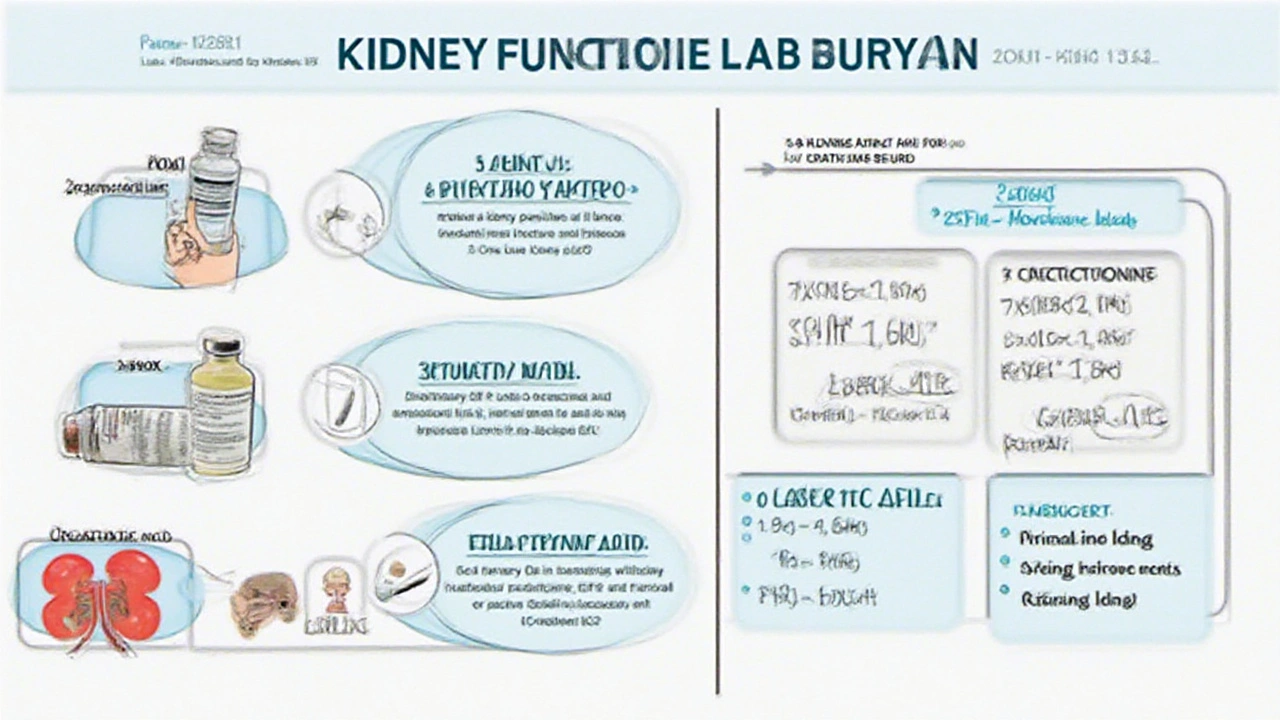Ever seen someone trust a medicine as if it’s a magic trick, only for the show to flop halfway through? Happens a lot with Lasix and kidney health. People expect furosemide (Lasix) to kick swelling and high blood pressure to the curb, but if kidney function drops, Lasix can fall flat on its face. For anyone relying on a water pill to do its job, that’s more than a letdown -- it can turn daily life into a marathon of puffy ankles and stubborn fluid. Here’s where knowing about GFR and creatinine comes in. These numbers quietly predict when it’s time for a smarter switch in diuretics, pushing doctors to try options like bumetanide or ethacrynic acid, which can offer better results. Weirdly, the solution is simple once you get the hang of how these labs work together with your meds. Let’s dig into what’s really happening and what you can do about it.
Why Lasix Stalls: The Role of GFR and Creatinine in Diuretic Power
Kidneys do more than filter gunk; they set the stage for almost every water pill out there. Lasix (furosemide) is famous because it worked well for so many years. But here’s the kicker: Lasix loses steam fast when your GFR (glomerular filtration rate) dips below about 30. GFR checks how well your kidneys filter the blood — think of it as a test of how many coffee grounds your filter can catch before needing to be cleaned. When this number drops, it’s a sign the filter is clogged. Creatinine, a chemical your muscles produce, sneaks into your blood and gets filtered by the kidneys. When kidneys slow down, creatinine builds up, signaling trouble.
So, what does this mean for anybody with failing kidneys? Well, Lasix is like a tired old vacuum: it can’t suck up much when the bag is already stuffed. It relies on your kidneys being able to get the drug inside the urine-making section. GFR under 30? The doors are half-shut. Studies back this up: patients with chronic kidney disease (especially stage 4 or higher) often show barely any difference after bumping up Lasix. Instead of just piling on more pills and risking hearing problems (yep, that’s a weird Lasix side effect), many nephrologists suggest moving to a different class altogether.
Here’s a pro tip: always check that latest creatinine value. That number, and your calculated GFR, matters way more than the dose on your Lasix bottle. If you find swelling isn’t budging much and your labs are climbing, it’s time to revisit your diuretic plan.

When to Consider Bumetanide or Ethacrynic Acid Instead
Ever wonder why hospitals keep a stash of bumetanide and ethacrynic acid, even though Lasix is everywhere? Turns out, these meds are small but mighty. Bumetanide (Bumex) especially packs a punch for people whose kidneys can barely keep up. Its chemical structure helps it get into the kidney’s filtering system even when things are running slow, so it keeps pulling fluid off the body when Lasix is waving a white flag.
The tipping point for changing meds really rests on those two labs: GFR and creatinine. Take this for example — a study from the British Journal of Clinical Pharmacology found that bumetanide is nearly 40 times more potent per milligram than Lasix, and keeps working longer in patients with severe renal impairment. That’s why most kidney docs instinctively reach for bumetanide the minute GFR hits the low 20s or teens. Mornings with swollen legs or gaining weight every single day? Your body is probably screaming for that switch.
Ethacrynic acid deserves a shout too, especially if there’s a weird reaction to Lasix or bumetanide. Ethacrynic acid isn’t a sulfa drug, so it’s safe for people with sulfa allergies. There’s even older data showing it can outperform Lasix in tough cases of heart failure plus kidney disease. Only downside? It can be rougher on the stomach and may cost more in some spots — but if you’re stuck, it’s worth it.
Here’s a common tip from nephrologists I know: Don’t wait for full-blown fluid overload before making a move. Look at your GFR trend. If your creatinine is climbing and Lasix isn’t cutting it, ask about switching early. It beats chasing your tail with higher and higher doses of the same med. You can check out more options for treating tough fluid overload in this guide to alternative to furosemide if you’re curious about every route that actually works.

Tips for Managing Diuretic Changes and Fluid Control at Home
Switching diuretics can feel awkward at first, especially if you’re used to the same pills for years. The body tends to notice big changes — sometimes peeing more, sometimes less, and sometimes feeling dizzy as fluid finds a new balance. Here’s what’s helped my family, friends, and patients stay on top of it without losing their minds.
- Weigh yourself, every day, first thing in the morning and keep a notebook right by the scale. A two-pound jump overnight usually means more fluid, not just extra pizza.
- Keep track of swelling. Are your socks leaving marks? Rings getting tight? These small signs can tell you way more than just guessing.
- Never skip labs. Kidney numbers don’t magically come back into range on their own. Even missing one round of bloodwork can mess up your treatment plan.
- Call your clinic or doctor’s office if you suddenly stop peeing, get dizzy, or can’t catch your breath. These are red flags — not ‘wait-and-see’ moments.
- For those stubborn days when the scale won’t budge, double-check diet. Extra salt from takeout or canned food can undo even the strongest water pill overnight.
- It sounds old-fashioned, but keep pills in a weekly organizer — trust me, with multiple med changes, it’s easy to forget what you’ve taken.
- If you do move to bumetanide or ethacrynic acid, watch out for muscle cramps and ask your doctor about potassium blood tests. These can sneak up fast after a med switch.
The shift to a new diuretic isn’t the end of the world. I’ve watched my own relatives, like my dad, go through several med changes after his GFR dipped with age. The key was keeping on top of his bloodwork and never shrugging off weird symptoms. Swapping out Lasix brought his swelling back under control and got him back to the garden, which he thought was all lost. If you’re struggling, keep the conversation open. The next med might be exactly what you need for stronger days ahead.

Mike Rothschild
July 13, 2025 AT 07:25Watch your potassium. Always.
Ron Prince
July 14, 2025 AT 19:54Sarah McCabe
July 15, 2025 AT 06:23King Splinter
July 15, 2025 AT 14:44Kristy Sanchez
July 16, 2025 AT 17:49Michael Friend
July 17, 2025 AT 09:45Jerrod Davis
July 17, 2025 AT 22:56Dominic Fuchs
July 19, 2025 AT 15:02Asbury (Ash) Taylor
July 20, 2025 AT 13:25Kenneth Lewis
July 20, 2025 AT 21:05Jim Daly
July 21, 2025 AT 00:49Tionne Myles-Smith
July 21, 2025 AT 17:09Leigh Guerra-Paz
July 23, 2025 AT 07:33Jordyn Holland
July 25, 2025 AT 06:44Jasper Arboladura
July 26, 2025 AT 17:23Mike Rothschild
July 28, 2025 AT 02:01